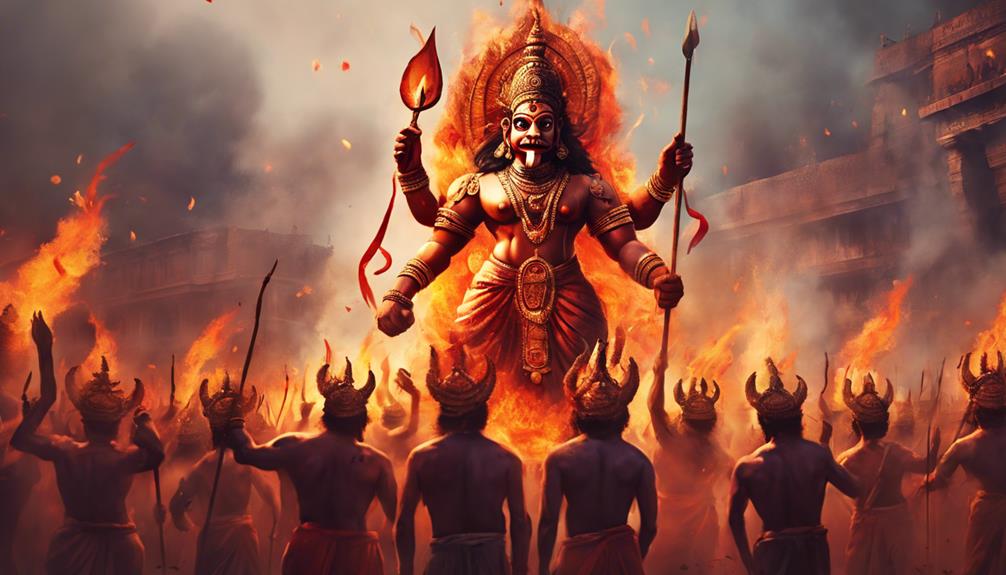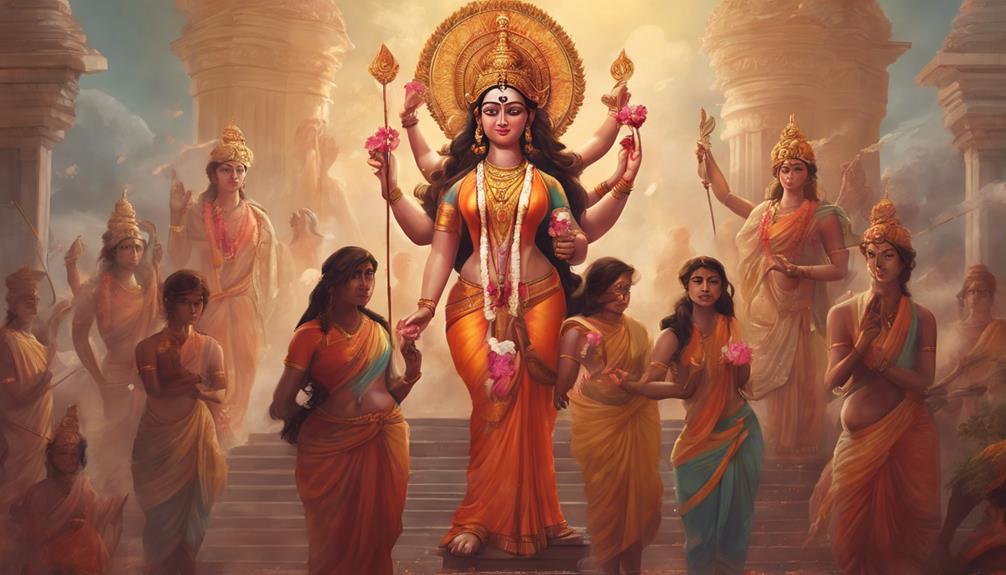In Navaratri and Dussehra festivals, devotees celebrate Goddess Durga through nine nights of worship, diverse forms of worship, and symbolic rituals that depict the victory of good over evil. The rituals during Navaratri are deeply traditional, honoring the Divine Feminine through fasting, prayers, and meditations dedicated to Goddess Durga, Lakshmi, and Saraswati.
Dussehra symbolizes the triumph of Lord Rama over Ravana, encouraging the upholding of moral values and fighting against negativity. The burning of Ravana effigies signifies the destruction of evil forces and reinforces the enduring power of righteousness. Seeking blessings from Goddess Durga fosters a spiritual bond and strengthens belief in her ability to vanquish evil. Explore further to understand the intricate layers of devotion and symbolism in these vibrant festivals.
Table of Contents
Key Takeaways
- Navaratri and Dussehra celebrate Goddess Durga through rituals, prayers, and offerings.
- Diverse forms of Durga are worshipped, highlighting her multifaceted nature.
- Devotees seek blessings from Goddess Durga for strength, protection, and guidance.
- Symbolic burning of Ravana effigies signifies victory of good over evil.
- Festivals emphasize devotion, spiritual reflection, and the triumph of righteousness.
Navaratri: Nine Nights of Devotion
During Navaratri, devotees immerse themselves in nine nights of profound worship and spiritual reflection. This festival, celebrating the Divine Feminine, honors the various forms of Goddess Durga. The sacred rituals performed during Navaratri are deeply rooted in tradition and symbolism.
The nine nights are divided into three sets, each dedicated to a different form of Goddess Durga: Durga, Lakshmi, and Saraswati. The first three nights are focused on Goddess Durga, symbolizing destruction of negative energies. The following three nights venerate Goddess Lakshmi, representing prosperity and wealth. The final three nights are dedicated to Goddess Saraswati, embodying knowledge and wisdom.
Devotees engage in fasting, prayer, and meditation during Navaratri. They visit temples, create beautiful altars at home, and participate in community gatherings. The rituals performed include singing devotional songs, chanting mantras, and performing aarti (light offering) to the Goddess.
Various Forms of Durga Worship
Exploring the rich tapestry of Durga worship reveals a diverse array of forms and practices deeply intertwined with cultural and spiritual significance. The worship of Goddess Durga encompasses various divine manifestations, each representing different aspects of feminine power and energy. From the fierce warrior form of Durga slaying demons to the nurturing and benevolent form as the mother goddess, devotees connect with her through these diverse representations.
Ritualistic offerings play an important role in Durga worship, symbolizing devotion and gratitude towards the goddess. Offerings of flowers, incense, fruits, and sweets are made during ceremonies and prayers, reflecting the belief in reciprocation of blessings from Durga. The act of offering these items is a way for devotees to express their reverence and seek the goddess's favor.
In essence, the various forms of Durga worship highlight the multifaceted nature of the goddess and provide devotees with different avenues to connect with her divine presence. Through rituals and offerings, followers engage in a spiritual dialogue with Durga, deepening their connection and seeking her blessings in different aspects of life.
Dussehra: Victory of Good Over Evil

The culmination of the Navaratri festival leads to Dussehra, a significant Hindu celebration symbolizing the victory of good over evil. Dussehra, also known as Vijayadashami, marks the triumph of Lord Rama over the demon king Ravana, showcasing the ultimate victory of righteousness. This auspicious day is a reminder that no matter how powerful evil may seem, it will always be defeated by the forces of good. The festival is deeply rooted in the epic Ramayana, where Lord Rama, aided by Lord Hanuman and his devoted wife Sita, vanquishes the ten-headed demon king Ravana after a fierce battle.
Dussehra isn't just a historical event but a symbolic representation of the ongoing battle between virtue and malevolence within individuals and society. It serves as a powerful message that good deeds, truth, and righteousness will inevitably prevail over wickedness and deceit. By celebrating this victory, people are encouraged to uphold moral values and fight against negativity in all its forms. Dussehra stands as a beacon of hope, reminding everyone that light will always dispel darkness in the end.
Symbolic Burning of Ravana Effigies
Symbolic burning of Ravana effigies during Dussehra portrays the ritualistic destruction of evil forces in a symbolic and ceremonious manner. This act holds significant cultural value in Hindu traditions, symbolizing the victory of good over evil. The practice finds its historical origins in the epic Ramayana, where Ravana, a demon king with ten heads, kidnapped Lord Rama's wife, Sita. Lord Rama, aided by his loyal devotee Hanuman and an army of monkeys, waged a battle against Ravana to rescue Sita. The eventual defeat of Ravana signifies the triumph of righteousness over malevolence.
The symbolic burning of Ravana effigies serves as a reminder of the consequences of hubris and wrongdoing. It reinforces the belief that ultimately, truth and virtue prevail. The act is deeply rooted in the collective consciousness of the Hindu community, resonating with themes of justice, morality, and the enduring power of good. By partaking in this ritual, individuals not only celebrate the victory of good but also affirm their commitment to upholding righteousness in the face of adversity.
Seeking Blessings From Goddess Durga

Seeking blessings from Goddess Durga is a revered practice deeply ingrained in the spiritual fabric of Hindu devotees during the auspicious period of Navaratri and Dussehra. The act of seeking divine blessings from Goddess Durga isn't merely a ritual but a profound spiritual connection that believers cherish. This connection signifies the devotee's faith in the Goddess's power to guide, protect, and bestow blessings upon them.
During Navaratri and Dussehra, devotees engage in prayers, fasting, and visit temples dedicated to Goddess Durga to seek her divine blessings. The belief in Goddess Durga's ability to vanquish evil and grant strength and wisdom is paramount during this time. Through these rituals, devotees express their gratitude, devotion, and reverence for the Goddess.
The act of seeking blessings from Goddess Durga fosters a spiritual bond between the devotee and the divine, creating a sense of peace, protection, and guidance. This practice reinforces the devotee's belief in the Goddess's benevolence and omnipotence, strengthening their resolve to face life's challenges with faith and courage.
Frequently Asked Questions
What Are Some Traditional Foods Eaten During Navaratri and Dussehra Celebrations?
During Navaratri and Dussehra, traditional foods like sabudana khichdi, kuttu puri, and singhare ke atte ki puri are enjoyed, reflecting festive recipes. These culinary traditions honor the celebrations with flavorful dishes that adhere to religious dietary restrictions.
Are There Any Specific Rituals or Customs That Are Unique to Navaratri and Dussehra Celebrations in Different Regions of India?
In different regions of India, Navaratri and Dussehra celebrations showcase unique customs and rituals. Regional variations add depth to the festivities, reflecting diverse cultural practices and beliefs. These distinctions contribute to the rich tapestry of Indian traditions.
How Do People Prepare for the Festivals of Navaratri and Dussehra in Terms of Decorating Their Homes and Setting up Altars for Goddess Durga?
To prepare for Navaratri and Dussehra, you adorn your home with vibrant decorations, creating festive altars for Goddess Durga. Intricate floral arrangements and elaborate lighting setups enhance the sacred atmosphere, symbolizing reverence and devotion.
Are There Any Specific Prayers or Mantras That Are Commonly Recited During Navaratri and Dussehra Festivities?
During Navaratri and Dussehra, devotees chant mantras like "Om Aim Hreem Kleem Chamundaye Viche" to honor Goddess Durga. These prayers hold deep spiritual significance, fostering meditation and devotional practices, enriching the festive experience with divine connectivity.
What Role Do Animals Like Horses and Elephants Play in the Grand Processions and Ceremonies Held During Dussehra Celebrations?
In Dussehra celebrations, animals like horses and elephants symbolize power and victory. They lead grand processions, embodying strength and auspiciousness. These majestic creatures play a significant role in parades, adding a touch of tradition and reverence.
Conclusion
To sum up, the festivals of Navaratri and Dussehra are vibrant celebrations that honor the goddess Durga and symbolize the triumph of good over evil. Through various forms of worship, rituals, and traditions, devotees seek blessings and guidance from Goddess Durga during these auspicious occasions.
The symbolic burning of Ravana effigies during Dussehra serves as a powerful reminder of the victory of righteousness and the defeat of malevolence. These festivals are deeply rooted in devotion and spiritual significance.